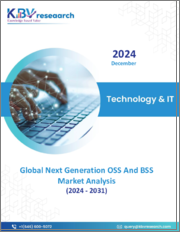
|
시장보고서
상품코드
1355719
세계의 차세대 OSS 및 BSS 시장 규모 조사 및 예측 : 아키텍처별, 네트워크별, 지역별 분석(2023-2030년)Global Next-generation OSS and BSS Market Size study & Forecast, by Architecture, by Networks and Regional Analysis, 2023-2030 |
||||||
세계의 차세대 OSS 및 BSS 시장은 2022년에 약 436억 달러로 평가되며, 예측 기간인 2023- 2030년에는 6.9% 이상의 건전한 성장률로 성장할 것으로 예측되고 있습니다.
차세대 OSS 및 BSS는 통신사 및 서비스 프로바이더가 업무, 서비스, 고객 관계를 효율적으로 관리하고 서비스 제공 및 고객 경험을 향상시킬 수 있는 고도화된 시스템을 말합니다. 차세대 OSS 및 BSS 시장은 IoT 기기 수요 증가와 스마트폰 보급 확대 등의 요인으로 확대되고 있습니다. 또한 스마트폰의 보급이 차세대 OSS 및 BSS 시장에 미치는 영향은 매우 크며, 모바일 서비스 수요 증가에 대응하고 고객 경험을 향상시키기 위한 고도화된 시스템에 대한 요구가 증가하고 있습니다.
2023년 Statista에 따르면 2023-2028년까지 세계 스마트폰 사용자 수는 9억 1,030만 달러 증가하여 17.33%의 성장률을 기록할 것으로 예상되며, 2028년에는 사용자 수가 62억 명에 달하고, 5년 연속 증가세를 보일 것으로 예상됩니다. 사물인터넷(IoT)의 발전은 차세대 OSS 및 BSS 시장에 큰 영향을 미치고 있는데, 이는 IoT 기기 및 서비스에서 생성되는 복잡한 네트워크와 데이터를 관리할 수 있는 고급 시스템이 필요하기 때문입니다. 사물인터넷(IoT) 기기 수는 2020년 97억 달러에서 2030년에는 3배 가까이 증가한 290억 달러 이상이 될 것으로 예상되며, 2030년까지 IoT 기기 수가 가장 많은 국가는 중국으로, 소비자가 사용하는 기기 수는 약 50억 개에 달할 것으로 예상됩니다. 또한 차세대 OSS 및 BSS의 기술 발전과 5G 네트워크의 채택이 증가함에 따라 유리한 성장 기회가 창출될 것으로 보입니다. 그러나 차세대 OSS 및 BSS 통합에 따른 높은 비용과 보안 및 개인 정보 보호에 대한 우려가 높아지면서 2023-2030년의 예측 기간 중 시장 성장을 저해할 것으로 보입니다.
차세대 세계의 OSS 및 BSS 시장 조사에서 고려된 주요 지역으로는 아시아태평양, 북미, 유럽, 라틴아메리카, 중동 및 아프리카가 있습니다. 북미는 다양한 산업 및 상업 분야에서 클라우드 컴퓨팅, 사물인터넷(IoT), M2M(Machine-to-Machine) 통신, 모바일 기기 등 첨단 기술 채택이 확대되면서 예측 기간 중 시장을 주도할 것으로 보입니다. 아시아태평양은 디지털화로 인한 스마트폰 보급 증가와 디지털 기기에 대한 인식 증가 등의 요인으로 예측 기간 중 가장 빠르게 성장하는 지역입니다. 또한 스마트 시티를 개발하고 기차역, 공항, 복합상업시설 등 주요 장소에 원활한 인터넷 접속을 제공하기 위한 정부의 구상은 이 지역 시장 성장을 확대할 것으로 예상됩니다.
이 연구의 목적은 최근 수년간 다양한 부문과 국가 시장 규모를 파악하고 향후 수년간 시장 규모를 예측하는 것입니다. 이 보고서는 조사 대상 국가의 산업의 질적/양적 측면을 포함하도록 설계되었습니다.
또한 시장의 미래 성장을 규정하는 촉진요인과 과제와 같은 중요한 측면에 대한 자세한 정보도 제공합니다. 또한 주요 기업의 경쟁 구도와 제품 제공에 대한 상세한 분석과 함께 이해관계자들이 투자할 수 있는 미시적 시장에서의 잠재적 기회도 포함합니다.
목차
제1장 주요 요약
제2장 세계의 OSS 및 BSS 시장의 정의와 범위
- 조사 목적
- 시장의 정의와 범위
- 업계의 진화
- 조사 범위
- 조사 대상년
- 통화 환산율
제3장 세계의 차세대 OSS 및 BSS 시장 역학
- 차세대 OSS 및 BSS 시장의 영향 분석(2020-2030년)
- 시장 촉진요인
- 스마트폰의 보급 확대
- IoT 기기의 수요 확대
- 시장이 해결해야 할 과제
- 차세대 OSS 및 BSS의 통합에 수반하는 고비용
- 보안과 프라이버시에 관한 우려의 증가
- 시장 기회
- 차세대 OSS 및 BSS에서 기술 진보의 증가
- 5G 네트워크의 채택 확대
- 시장 촉진요인
제4장 차세대 세계의 OSS 및 BSS 시장 산업 분석
- Porter's 5 Force 모델
- 공급 기업의 교섭력
- 구매자의 교섭력
- 신규 진출업체의 위협
- 대체품의 위협
- 경쟁 기업간 경쟁 관계
- Porter's 5 Force 영향 분석
- PEST 분석
- 정치
- 경제
- 사회
- 기술
- 환경
- 법률
- 주요 투자 기회
- 주요 성공 전략
- COVID-19 영향 분석
- 파괴적 동향
- 업계 전문가의 시점
- 애널리스트의 결론·제안
제5장 차세대 세계의 OSS 및 BSS 시장 : 아키텍처별
- 시장 스냅숏
- 차세대 세계의 OSS 및 BSS 시장 : 아키텍처별, 실적·잠재력 분석
- 차세대 세계의 OSS 및 BSS 시장 : 아키텍처별, 추정·예측, 2020-2030년
- 차세대 OSS 및 BSS 시장, 하위 부문별 분석
- 매출 관리
- 서비스 풀필먼트
- 서비스 보증
- 고객 관리
- 네트워크 관리 시스템
제6장 차세대 세계의 OSS 및 BSS 시장 : 네트워크별
- 시장 스냅숏
- 차세대 세계의 OSS 및 BSS 시장 : 네트워크별, 실적·잠재력 분석
- 차세대 세계의 OSS 및 BSS 시장 : 네트워크별, 추정·예측, 2020-2030년
- 차세대 OSS 및 BSS 시장, 하위 부문별 분석
- 케이블 & 위성
- 고정·무선
- 모바일
- MVNO/MVNE
- 기타
제7장 차세대 세계의 OSS 및 BSS 시장 : 지역별 분석
- 주요 국가
- 주요 신흥 국가
- 차세대 OSS 및 BSS 시장의 지역별 시장 스냅숏
- 북미
- 미국
- 아키텍처, 추정·예측, 2020-2030년
- 네트워크, 추정·예측, 2020-2030년
- 캐나다
- 미국
- 유럽 OSS 및 BSS 시장 스냅숏
- 영국
- 독일
- 프랑스
- 스페인
- 이탈리아
- 기타 유럽
- 아시아태평양의 차세대 OSS 및 BSS 시장 스냅숏
- 중국
- 인도
- 일본
- 호주
- 한국
- 기타 아시아태평양
- 라틴아메리카 차세대 OSS 및 BSS 시장 스냅숏
- 브라질
- 멕시코
- 중동 및 아프리카
- 사우디아라비아
- 남아프리카공화국
- 기타 중동 및 아프리카
제8장 경쟁 정보
- 주요 기업의 SWOT 분석
- 주요 시장 전략
- 기업 개요
- Hewlett Packard Enterprise Development LP
- 주요 정보
- 개요
- 재무(데이터의 가용성에 따름)
- 제품 개요
- 최근 동향
- Huawei Technologies Co., Ltd.
- Capgemini SE
- Accenture plc.
- Amdocs, Inc.
- CSG Systems International, Inc.
- Oracle Corporation
- International Business Machines Corporation
- LogNet Systems Ltd
- Texas Instruments Incorporated
- Hewlett Packard Enterprise Development LP
제9장 조사 프로세스
- 조사 프로세스
- 데이터 광업
- 분석
- 시장 추정
- 검증
- 출판
- 조사 속성
- 조사 전제조건
Global Next-generation OSS and BSS Market is valued at approximately USD 43.6 billion in 2022 and is anticipated to grow with a healthy growth rate of more than 6.9% over the forecast period 2023-2030. The Next-generation OSS and BSS refers to advanced systems that help telecom and service providers manage operations, services, and customer relationships efficiently, enhancing service delivery and customer experience. The Next-generation OSS and BSS Market is expanding because of factors such as rising demand in IoT devices and growing adoption of smartphones. Moreover, the growing adoption of smartphones has a significant impact on the Next-generation OSS and BSS market, driving the need for advanced systems to support the increasing demands of mobile services and enhance customer experiences.
According to Statista in 2023, the total number of smartphone users worldwide is estimated to increase by USD 910.3 million, between 2023 to 2028, representing a growth rate of 17.33 percent. By 2028, it is expected to reach 6.2 billion users, marking the fifth consecutive year of growth. The rising advancements in the Internet of Things (IoT) have a significant impact on the Next-generation OSS and BSS market, as they require advanced systems to manage the complex networks and data generated by IoT devices and services. According to Statista in 2022, the number of Internet of Things (IoT) devices worldwide is expected to nearly triple from USD 9.7 billion in 2020 to over USD 29 billion by 2030. By 2030, China is projected to have the largest number of IoT devices, with around 5 billion devices used by consumers. In addition, rising technological advancements in Next-generation OSS and BSS and increasing adoption of 5G networks would create a lucrative growth opportunity. However, the high cost associated to integration of Next-generation OSS and BSS and growing security and privacy concerns stifle market growth throughout the forecast period of 2023-2030.
The key regions considered for the Global Next-generation OSS and BSS Market study includes Asia Pacific, North America, Europe, Latin America, and Middle East & Africa. North America dominates the market during the forecast period owing to the growing adoption of advanced technologies such as cloud computing, Internet of Things (IoT), machine-to-machine (M2M) communications, and mobile devices across diverse industries and commercial sectors. Asia Pacific region is the fastest growing region during the forecast period owing to the factors such as a rise in smartphone adoption driven by digitalization and increased awareness of digital devices. Furthermore, government initiatives aimed at developing smart cities and providing seamless internet connectivity in key locations such as railway stations, airports, and commercial complexes are anticipated to increase market growth in the region.
Major market player included in this report are:
- Hewlett Packard Enterprise Development LP
- Huawei Technologies Co., Ltd.
- Capgemini SE
- Accenture plc.
- Amdocs, Inc.
- CSG Systems International, Inc.
- Oracle Corporation
- International Business Machines Corporation
- LogNet Systems Ltd
- Texas Instruments Incorporated
Recent Developments in the Market:
- In August 2022, Oracle has renewed a strategic agreement with AT&T that will help give new capacity and capabilities for the company's database and application workloads running in Oracle Cloud. The new five-year deal will build on AT&T's use of Oracle Fusion Cloud Enterprise Resource Planning (ERP), Oracle Fusion Cloud Customer Experience (CX), Oracle Cloud Infrastructure, and other Oracle Cloud services.
Global Next-generation OSS and BSS Market Report Scope:
- Historical Data: 2020 - 2021
- Base Year for Estimation: 2022
- Forecast period: 2023-2030
- Report Coverage: Revenue forecast, Company Ranking, Competitive Landscape, Growth factors, and Trends
- Segments Covered: Architecture, Networks, Region
- Regional Scope: North America; Europe; Asia Pacific; Latin America; Middle East & Africa
- Customization Scope: Free report customization (equivalent up to 8 analyst's working hours) with purchase. Addition or alteration to country, regional & segment scope*
The objective of the study is to define market sizes of different segments & countries in recent years and to forecast the values to the coming years. The report is designed to incorporate both qualitative and quantitative aspects of the industry within countries involved in the study.
The report also caters detailed information about the crucial aspects such as driving factors & challenges which will define the future growth of the market. Additionally, it also incorporates potential opportunities in micro markets for stakeholders to invest along with the detailed analysis of competitive landscape and product offerings of key players. The detailed segments and sub-segment of the market are explained below:
By Architecture:
- Revenue Management
- Service Fulfillment
- Service Assurance
- Customer Management
- Network Management Systems
By Networks:
- Cable & Satellite
- Fixed & Wireless
- Mobile
- MVNO/MVNE
- Others
By Region:
- North America
- U.S.
- Canada
- Europe
- UK
- Germany
- France
- Spain
- Italy
- ROE
- Asia Pacific
- China
- India
- Japan
- Australia
- South Korea
- RoAPAC
- Latin America
- Brazil
- Mexico
- Middle East & Africa
- Saudi Arabia
- South Africa
- Rest of Middle East & Africa
Table of Contents
Chapter 1. Executive Summary
- 1.1. Market Snapshot
- 1.2. Global & Segmental Market Estimates & Forecasts, 2020-2030 (USD Billion)
- 1.2.1. Next-generation OSS and BSS Market, by Region, 2020-2030 (USD Billion)
- 1.2.2. Next-generation OSS and BSS Market, by Architecture, 2020-2030 (USD Billion)
- 1.2.3. Next-generation OSS and BSS Market, by Networks, 2020-2030 (USD Billion)
- 1.3. Key Trends
- 1.4. Estimation Methodology
- 1.5. Research Assumption
Chapter 2. Global Next-generation OSS and BSS Market Definition and Scope
- 2.1. Objective of the Study
- 2.2. Market Definition & Scope
- 2.2.1. Industry Evolution
- 2.2.2. Scope of the Study
- 2.3. Years Considered for the Study
- 2.4. Currency Conversion Rates
Chapter 3. Global Next-generation OSS and BSS Market Dynamics
- 3.1. Next-generation OSS and BSS Market Impact Analysis (2020-2030)
- 3.1.1. Market Drivers
- 3.1.1.1. Growing adoption of smartphones
- 3.1.1.2. Rising demand in IoT devices
- 3.1.2. Market Challenges
- 3.1.2.1. High cost associated to integration of Next-generation OSS and BSS
- 3.1.2.2. Growing security and privacy concerns
- 3.1.3. Market Opportunities
- 3.1.3.1. Rising technological advancements in Next-generation OSS and BSS
- 3.1.3.2. Increasing adoption of 5G networks
- 3.1.1. Market Drivers
Chapter 4. Global Next-generation OSS and BSS Market Industry Analysis
- 4.1. Porter's 5 Force Model
- 4.1.1. Bargaining Power of Suppliers
- 4.1.2. Bargaining Power of Buyers
- 4.1.3. Threat of New Entrants
- 4.1.4. Threat of Substitutes
- 4.1.5. Competitive Rivalry
- 4.2. Porter's 5 Force Impact Analysis
- 4.3. PEST Analysis
- 4.3.1. Political
- 4.3.2. Economical
- 4.3.3. Social
- 4.3.4. Technological
- 4.3.5. Environmental
- 4.3.6. Legal
- 4.4. Top investment opportunity
- 4.5. Top winning strategies
- 4.6. COVID-19 Impact Analysis
- 4.7. Disruptive Trends
- 4.8. Industry Expert Perspective
- 4.9. Analyst Recommendation & Conclusion
Chapter 5. Global Next-generation OSS and BSS Market, by Architecture
- 5.1. Market Snapshot
- 5.2. Global Next-generation OSS and BSS Market by Architecture, Performance - Potential Analysis
- 5.3. Global Next-generation OSS and BSS Market Estimates & Forecasts by Architecture 2020-2030 (USD Billion)
- 5.4. Next-generation OSS and BSS Market, Sub Segment Analysis
- 5.4.1. Revenue Management
- 5.4.2. Service Fulfilment
- 5.4.3. Service Assurance
- 5.4.4. Customer Management
- 5.4.5. Network Management Systems
Chapter 6. Global Next-generation OSS and BSS Market, by Networks
- 6.1. Market Snapshot
- 6.2. Global Next-generation OSS and BSS Market by Networks , Performance - Potential Analysis
- 6.3. Global Next-generation OSS and BSS Market Estimates & Forecasts by Networks 2020-2030 (USD Billion)
- 6.4. Next-generation OSS and BSS Market, Sub Segment Analysis
- 6.4.1. Cable & Satellite
- 6.4.2. Fixed & Wireless
- 6.4.3. Mobile
- 6.4.4. MVNO/MVNE
- 6.4.5. Others
Chapter 7. Global Next-generation OSS and BSS Market, Regional Analysis
- 7.1. Top Leading Countries
- 7.2. Top Emerging Countries
- 7.3. Next-generation OSS and BSS Market, Regional Market Snapshot
- 7.4. North America Next-generation OSS and BSS Market
- 7.4.1. U.S. Next-generation OSS and BSS Market
- 7.4.1.1. Architecture breakdown estimates & forecasts, 2020-2030
- 7.4.1.2. Networks breakdown estimates & forecasts, 2020-2030
- 7.4.2. Canada Next-generation OSS and BSS Market
- 7.4.1. U.S. Next-generation OSS and BSS Market
- 7.5. Europe Next-generation OSS and BSS Market Snapshot
- 7.5.1. U.K. Next-generation OSS and BSS Market
- 7.5.2. Germany Next-generation OSS and BSS Market
- 7.5.3. France Next-generation OSS and BSS Market
- 7.5.4. Spain Next-generation OSS and BSS Market
- 7.5.5. Italy Next-generation OSS and BSS Market
- 7.5.6. Rest of Europe Next-generation OSS and BSS Market
- 7.6. Asia-Pacific Next-generation OSS and BSS Market Snapshot
- 7.6.1. China Next-generation OSS and BSS Market
- 7.6.2. India Next-generation OSS and BSS Market
- 7.6.3. Japan Next-generation OSS and BSS Market
- 7.6.4. Australia Next-generation OSS and BSS Market
- 7.6.5. South Korea Next-generation OSS and BSS Market
- 7.6.6. Rest of Asia Pacific Next-generation OSS and BSS Market
- 7.7. Latin America Next-generation OSS and BSS Market Snapshot
- 7.7.1. Brazil Next-generation OSS and BSS Market
- 7.7.2. Mexico Next-generation OSS and BSS Market
- 7.8. Middle East & Africa Next-generation OSS and BSS Market
- 7.8.1. Saudi Arabia Next-generation OSS and BSS Market
- 7.8.2. South Africa Next-generation OSS and BSS Market
- 7.8.3. Rest of Middle East & Africa Next-generation OSS and BSS Market
Chapter 8. Competitive Intelligence
- 8.1. Key Company SWOT Analysis
- 8.1.1. Company 1
- 8.1.2. Company 2
- 8.1.3. Company 3
- 8.2. Top Market Strategies
- 8.3. Company Profiles
- 8.3.1. Hewlett Packard Enterprise Development LP
- 8.3.1.1. Key Information
- 8.3.1.2. Overview
- 8.3.1.3. Financial (Subject to Data Availability)
- 8.3.1.4. Product Summary
- 8.3.1.5. Recent Developments
- 8.3.2. Huawei Technologies Co., Ltd.
- 8.3.3. Capgemini SE
- 8.3.4. Accenture plc.
- 8.3.5. Amdocs, Inc.
- 8.3.6. CSG Systems International, Inc.
- 8.3.7. Oracle Corporation
- 8.3.8. International Business Machines Corporation
- 8.3.9. LogNet Systems Ltd
- 8.3.10. Texas Instruments Incorporated
- 8.3.1. Hewlett Packard Enterprise Development LP
Chapter 9. Research Process
- 9.1. Research Process
- 9.1.1. Data Mining
- 9.1.2. Analysis
- 9.1.3. Market Estimation
- 9.1.4. Validation
- 9.1.5. Publishing
- 9.2. Research Attributes
- 9.3. Research Assumption



















